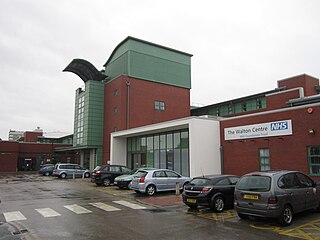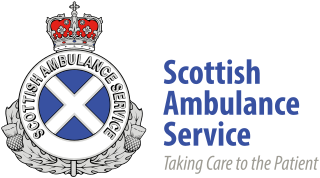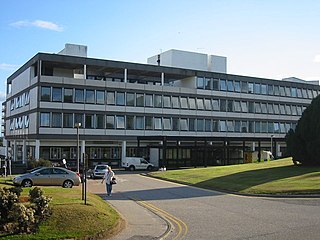Related Research Articles

An emergency department (ED), also known as an accident and emergency department (A&E), emergency room (ER), emergency ward (EW) or casualty department, is a medical treatment facility specializing in emergency medicine, the acute care of patients who present without prior appointment; either by their own means or by that of an ambulance. The emergency department is usually found in a hospital or other primary care center.
A trauma center, or trauma centre, is a hospital equipped and staffed to provide care for patients suffering from major traumatic injuries such as falls, motor vehicle collisions, or gunshot wounds. A trauma center may also refer to an emergency department without the presence of specialized services to care for victims of major trauma.

Addenbrooke's Hospital is a large teaching hospital and research centre in Cambridge, England, with strong affiliations to the University of Cambridge. Addenbrooke's Hospital is located on the Cambridge Biomedical Campus. It is run by Cambridge University Hospitals NHS Foundation Trust and is a designated academic health science centre. It is also the East of England's major trauma centre and was the first such centre to be operational in the United Kingdom.

The Walton Centre, formerly known as the Walton Centre for Neurology and Neurosurgery, is a major neurology hospital located in the suburb of Fazakerley in the city of Liverpool, England. It is one of several specialist hospitals located within the Liverpool City Region alongside Liverpool Heart and Chest Hospital, Alder Hey Children's Hospital, Liverpool Women's Hospital, Mersey Regional Burns and Plastic Surgery Unit and Clatterbridge Cancer Centre. The wards in the hospital are all named after pioneering neurosurgeons in the 20th and 21st century. It is managed by the Walton Centre NHS Foundation Trust.

London's Air Ambulance Charity is a registered charity that operates a helicopter emergency medical service (HEMS) dedicated to responding to serious trauma emergencies in and around London. Using a helicopter from 08:00 to sunset and rapid response vehicles by night, the service performs advanced medical interventions at the scene of the incident in life-threatening, time-critical situations.

The Queen Victoria Hospital (QVH), located in East Grinstead, West Sussex, England is the specialist reconstructive surgery centre for the south east of England, and also provides services at clinics across the region. It has become world-famous for its pioneering burns and plastic surgery. The hospital was named after Queen Victoria. It is managed by the Queen Victoria Hospital NHS Foundation Trust.

The James Cook University Hospital is a tertiary referral hospital and regional major trauma centre in Middlesbrough, North Yorkshire, England located on the A172. Having 1,046 beds, it caters for most specialities and forms part of the South Tees Hospitals NHS Foundation Trust, along with the Friarage Hospital in Northallerton.

The Scottish Ambulance Service is part of NHS Scotland, which serves all of Scotland's population. The Scottish Ambulance Service is governed by a special health board and is funded directly by the Health and Social Care Directorates of the Scottish Government.

Leeds General Infirmary, also known as the LGI, is a large teaching hospital based in the centre of Leeds, West Yorkshire, England, and is part of the Leeds Teaching Hospitals NHS Trust. Its previous name The General Infirmary at Leeds is still sometimes used.

Aberdeen Royal Infirmary is the largest hospital in the Grampian area, located on the Foresterhill site in Aberdeen, Scotland. ARI is a teaching hospital with around 900 inpatient beds, offering tertiary care for a population of over 600,000 across the north of Scotland. It offers all medical specialities with the exception of heart and liver transplants. It is managed by NHS Grampian.
Southampton General Hospital (SGH) is a large teaching hospital in Southampton, Hampshire, England run by University Hospital Southampton NHS Foundation Trust.

Stobhill Hospital is located in Springburn in the north of Glasgow, Scotland. It serves the population of North Glasgow and part of East Dunbartonshire. It is managed by NHS Greater Glasgow and Clyde.

Emergency medical services in the United Kingdom provide emergency care to people with acute illness or injury and are predominantly provided free at the point of use by the four National Health Services (NHS) of England, Scotland, Wales, and Northern Ireland. Emergency care including ambulance and emergency department treatment is only free to UK residents and a charge may be made to those not entitled to free NHS care.

NHS Borders is one of the fourteen health boards within NHS Scotland. It provides healthcare services for the Scottish Borders, the south east region of Scotland. NHS Borders is headquartered in Melrose.
NHS Highland is one of the fourteen regions of NHS Scotland. Geographically, it is the largest Health Board, covering an area of 32,500 km2 (12,500 sq mi) from Kintyre in the south-west to Caithness in the north-east, serving a population of 320,000 people. In 2016–17 it had an operating budget of £780 million. It provides prehospital care, primary and secondary care services.

University Hospital Wishaw is a district general hospital in Wishaw, North Lanarkshire, situated between the areas of Craigneuk to the north and Netherton to the south. The hospital, managed by NHS Lanarkshire, is 11 miles southeast of Glasgow.
North Bristol NHS Trust is a National Health Service trust that provides community healthcare and hospital services to Bristol, South Gloucestershire, and North Somerset, England. The trust employs over 8,000 staff and delivers healthcare through several medical institutions, including Southmead Hospital, Cossham Hospital, and the Bristol Centre for Enablement, as well as through various community-based clinics. In addition, medical teaching facilities are provided in association with the University of the West of England, Bristol University, and the University of Bath.

The Queen Elizabeth University Hospital (QEUH) is a 1,677-bed acute hospital located in Govan, in the south-west of Glasgow, Scotland. The hospital is built on the site of the former Southern General Hospital and opened at the end of April 2015. The hospital comprises a 1,109-bed adult hospital, a 256-bed children's hospital and two major Emergency Departments; one for adults and one for children. There is also an Immediate Assessment Unit for local GPs and out-of-hours services, to send patients directly, without having to be processed through the Emergency Department. The retained buildings from the former Southern General Hospital include the Maternity Unit, the Institute of Neurological Sciences, the Langlands Unit for medicine of the elderly and the laboratory. The whole facility is operated by NHS Greater Glasgow and Clyde, and is one of the largest acute hospital campuses in Europe.

The British Association for Immediate Care Scotland is an organisation involved with prehospital care. It has the aims of providing encouragement and aid with the formation of immediate care schemes and to provide training to support those working in prehospital care. It shares its origins with the British Association for Immediate Care (BASICS), which has UK wide coverage. In 1993, the British Association for Immediate Care began running prehospital care courses in Scotland, which were met with a warm welcome and it became clear there was a large audience for such education, especially in remote and rural areas of Scotland. This need for training and organisational leadership became clearer after the 1994 Scotland RAF Chinook crash on the Mull of Kintyre. This led to the training provided by BASICS to be modified for a more rural setting, and to the development of BASICS Scotland as a separate organisation in 2002.

The Prehospital Immediate Care and Trauma (PICT) Team is a prehospital care team which operates from Raigmore Hospital emergency department in Inverness, Scotland. It receives funding from NHS Highland, BASICS Scotland and the Scottish Trauma Network.
References
- 1 2 "Major Trauma Centre: Questions and Answers". Oxford University Hospitals Foundation Trust. Retrieved 21 November 2018.
- ↑ "Cardiff major trauma centre to go ahead". BBC News. BBC. 29 March 2018. Retrieved 25 January 2019.
- ↑ "Major Trauma Centres in England" (PDF). NHS. October 2016. Retrieved 21 November 2018.
- ↑ "Regionalisation of trauma care in England". Bone & Joint Journal . 1 September 2016. doi:10.1302/0301-620X.98B9.37525.
- ↑ "Map". Scottish Trauma Network. Retrieved 10 November 2019.
- ↑ "First of new major trauma centres opens in Aberdeen". BBC News. 1 October 2018.